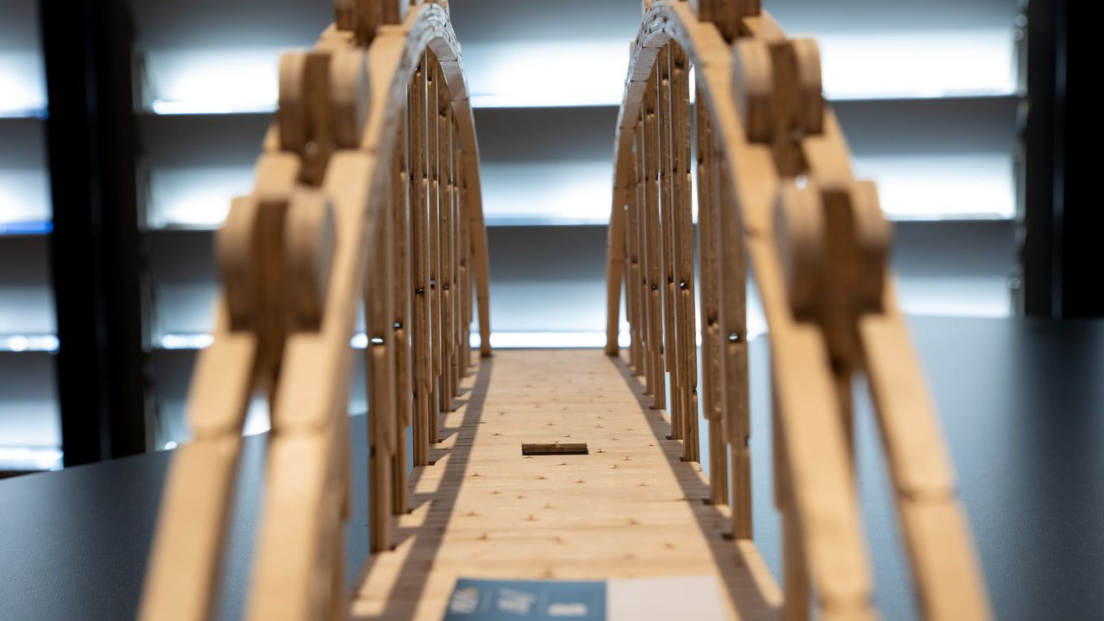When glacier sticks carry over a ton…

36 teams with 92 apprentices and FH students from all three parts of the country presented their constructions at the 3rd National Bridge Construction Competition of the Swiss Association of Road and Transport Professionals (VSS) at the Kongresshaus in Biel. The students and apprentices in the professions of draughtsmen and carpenters were allowed to use only glacier sticks and glue for their bridge models. The highlight was the breaking test on the test bench, which was used to choose the most effective bridge. The students' team from the ZHAW Winterthur won with a new record: their construction, weighing around 1 kg, carried a load of 1060 kg! The title among the apprentices was won by the team from the Wetzikon Vocational School, whose bridge withstood 773 kg.
A box of ice cream sticks, a tube of glue and creativity and intuition: that’s all it took to take part in Switzerland’s national bridge-building competition. The interest of the vocational schools from the three language regions was correspondingly great. The 64 participating trainees in the professions of draughtsmen and draughtswomen in the fields of civil engineering, geomatics, architecture, landscape architecture or spatial planning as well as carpenters constructed their bridge models in
their free time and invested up to 100 hours in it. The competition is also increasingly popular with the FH students, who participated with eight teams and 21 participants. The bridge-building competition is organised by the VSS together with the engineering firm AJS.
The presentation of the bridge models in the congress centre in Biel showed the whole range of creativity of the students: From elegant and light to massive and heavy, inspired by classical forms or simply springing from free imagination, meticulously worked out to the last detail or rather improvised. Jean-Marc Jeanneret, President of the organising Association of Swiss Road and Transport Professionals (VSS), was also pleased with the huge
variety of the models presented. For him, this competition, which has been established in many countries for years, has another effect that should not be underestimated, especially in the digital age: “When you assemble the construction ‘by hand’, you understand it in the truest sense of the word. Weak points become more concretely apparent than with static calculations or 3D models on the computer. In this way, learners gain a lot of knowledge in a playful way, which they otherwise often have to painstakingly acquire
. That’s why this competition is also a good introduction to professional life.”
The highlight of the event was the resilience test, with which the most effective bridge was chosen. First crackling, then crashing and with much applause from the audience, the bridge models break on the test bench. The effectiveness of the bridge is rated according to the load-bearing capacity achieved in relation to its own weight. This evaluation formula rewards those who arrive at the most efficient solution with a minimum of material consumption – entirely in the spirit of a resource-efficient
economy.
As in the previous year, the team from the ZHAW Winterthur solved this task best among the students. Their bridge carried a load of an incredible 1060 kg! The three students Pascal Lämmler, Fabio Schäfer and Naatan Lohrer not only won a cheque for 1000 Swiss francs, they also won the “maximum load” category and set a new record. A team also dominated in the apprentice category: the Wetzikon Vocational School with Valentin Voll, Pascal Roffler and Denis Bilgin won both the “most effective bridge” and the “maximum load” category (773 kg).